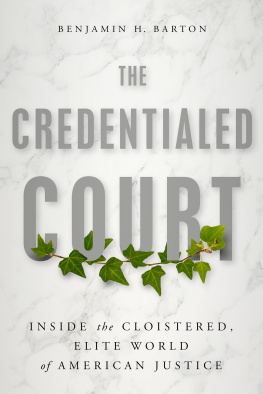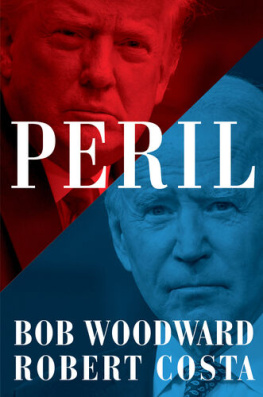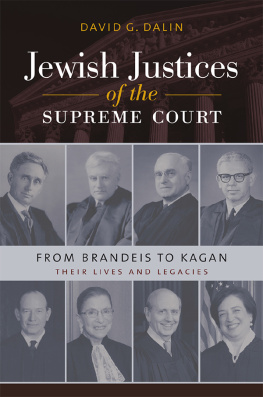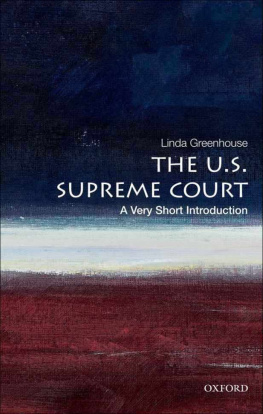Contents
Page List
Guide


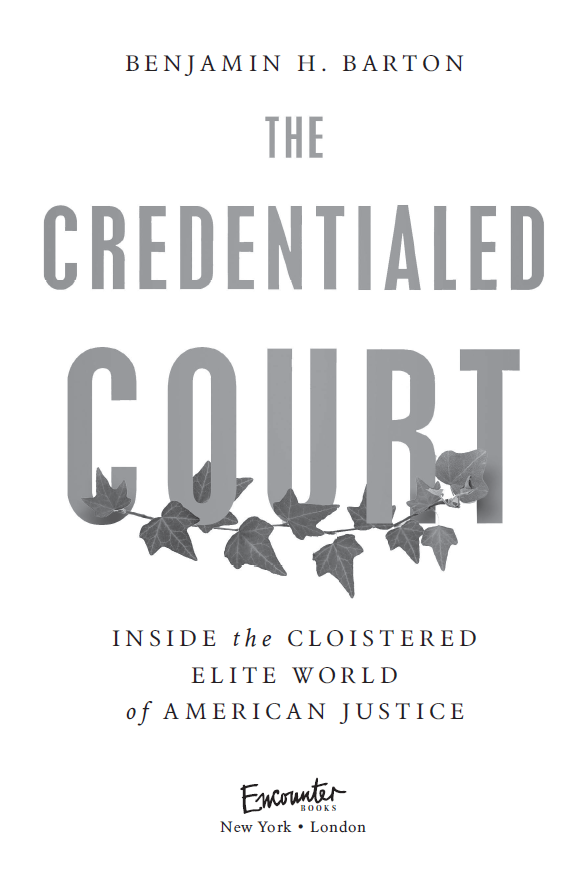
2022 by Benjamin H. Barton
All rights reserved. No part of this publication may be reproduced, stored in a retrieval system, or transmitted, in any form or by any means, electronic, mechanical, photocopying, recording, or otherwise, without the prior written permission of Encounter Books, 900 Broadway, Suite 601, New York, New York, 10003.
First American edition published in 2022 by Encounter Books, an activity of Encounter for Culture and Education, Inc., a nonprofit, tax-exempt corporation. Encounter Books website address: www.encounterbooks.com
Manufactured in the United States and printed on acid-free paper. The paper used in this publication meets the minimum requirements of ANSI/NISO Z39.481992 (R 1997) (Permanence of Paper).
FIRST AMERICAN EDITION
LIBRARY OF CONGRESS CATALOGING-IN-PUBLICATION DATA
Library of Congress Cataloging-in-Publication Data
Names: Barton, Benjamin H., 1969author.
Title: The Credentialed Court: Inside the Cloistered, Elite World of American Justice / Benjamin H. Barton.
Description: First American edition. | New York: Encounter Books, 2022. Includes bibliographical references and index.
Identifiers: LCCN 2021004437 (print) | LCCN 2021004438 (ebook) ISBN 9781641772044 (hardcover) | ISBN 9781641772051 (ebook) Subjects: LCSH: United States. Supreme CourtOfficials and employeesSelection and appointmentHistory. JudgesSelection and appointmentUnited StatesHistory.
Classification: LCC KF8748 .B277 2022 (print) | LCC KF8748 (ebook) DDC 347.73/2634dc23
LC record available at https://lccn.loc.gov/2021004437
LC ebook record available at https://lccn.loc.gov/2021004438
1 2 3 4 5 6 7 8 9 20 22
CONTENTS

T hose who followed the Supreme Court confirmation processes of Merrick Garland and Brett Kavanaugh likely concluded that the country has never been more divided on what makes a good Supreme Court Justice. Kavanaughs hearings and processes were among the most divisive and brutal in the history of the Court. Kavanaugh at least had a hearing. Obama nominee Merrick Garland was announced dead on arrival in the Senate, and he did not even get a chance to make his case.
The roil in the Senate is, of course, just a reflection of the political reality that the Supreme Court and the selection of Justices has become a preeminent political issue. As with many other trends, Donald Trump made this subtext the text in his first presidential campaign. Trump released a list of twenty-one potential nominees (almost all Federalist Society choices and rock-ribbed conservative originalists) ahead of the election in an effort to win over Republican voters who might have otherwise objected to other aspects of Trumps campaign and lifestyle. Candidate Trump loved to trot out the specter of multiple Hillary Clinton nominees as a critical reason why Republicans, evangelicals, libertarians, and others should vote for him. He wasnt exactly subtleconsider this quote, from a 2016 rally in Cedar Rapids: If you really like Donald Trump, thats great, but if you dont you have to vote for me anyway. You know why? Supreme Court Judges. You have no choice, sorry, sorry, sorry.
The tactic worked well in 2016. In the immediate aftermath of the release of the infamous Access Hollywood audiotape, Franklin Graham advised his followers to stick with Trump: Hold your nose and go vote, he said. You have to decide which one of the two [presidential candidates] you would trust to appoint justices that are going to protect our religious freedom as Christians.
Yet despite deep political divisions, Americans have unwittingly come to a different sort of consensus on Supreme Court Justices. This consensus is reflected in the remarkably similar educational, professional, and geographic backgrounds of recent appointees. Here are the backgrounds of three recent nominees listed anonymously and in no particular order. See if you can tell who is who:
NOMINEE ONE grew up in an upper-middle-class family and was the child of two lawyers. He attended an exclusive suburban private high school and graduated with a distinguished record. He then attended Columbia University as an undergraduate. He went straight from Columbia to Harvard Law School where he graduated cum laude. Nominee One was awarded a prestigious Marshall Scholarship to study at Oxford and eventually received a doctorate in Philosophy from Oxford. Nominee One clerked for a distinguished judge on the D.C. Circuit and then went on to clerk on the Supreme Court. After the clerkship, Nominee One stayed in D.C. and worked as an associate and then a partner at a top D.C. law firm. Nominee One then served as the deputy attorney general and acting associate attorney general before being appointed to serve as a federal court of appeals judge himself. He served as a federal judge for eleven years before being nominated to join the Supreme Court.
NOMINEE TWO grew up in an upper-middle-class household. His father ran his own advertising agency and his mother was the director of volunteer services at a religious organization. He grew up in a nice suburb and graduated as valedictorian of a public high school. He went on to attend Harvard on a scholarship and graduated summa cum laude. He went straight on to Harvard Law School and graduated magna cum laude three years later. Nominee Two then clerked for a prestigious judge on the Second Circuit before gaining a Supreme Court clerkship the next year. Over the course of his legal career Nominee Two worked in the Department of Justice for four years, including a stretch as deputy associate attorney general, as an associate and partner in a prestigious D.C. law firm, and as an assistant U.S. attorney in Washington, D.C. Nominee Two was then appointed to the D.C. Circuit as a Judge. He served as a judge for nineteen years before his nomination to the Supreme Court.
NOMINEE THREE grew up upper-middle class, the child of two lawyers. He attended an exclusive suburban private high school, where he excelled in his classes. He attended Yale undergraduate and went straight on to Yale Law School. He then clerked for two different prestigious federal court of appeals judges and spent a year as a lawyer in the Solicitor Generals Office before gaining his own Supreme Court clerkship. Over the course of his legal career he worked in an independent counsels office, the White House Counsels Office, briefly in a large law firm, and as the White House Staff Secretary. He was then appointed to the D.C. Circuit as a Judge, where he served for twelve years before his nomination.
If you guessed Gorsuch (1), Garland (2), and Kavanaugh (3), then you know a lot of granular trivia about those three individuals, because the differences in their life experiences and resumes are so few. In fact, the radical similarity of these three men tells us volumes about the current model of Supreme Court Justice and just how much that model has changed over the years.
It was not always thus. This book is a study of the backgrounds of Americas Supreme Court Justices, starting with the first, John Jay, and continuing through Amy Coney Barrett. I studied and quantified the pre-Court life experiences of all 115 Supreme Court Justices. I use this study to answer a series of related empirical questions and then to draw some conclusions about the state of the Supreme Court and the country as a whole. I also tell a series of anecdotes about the lives of these Justices before they joined the Court to show what were missing on todays Supreme Court.

